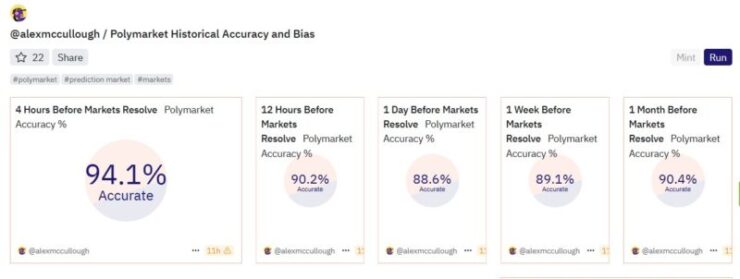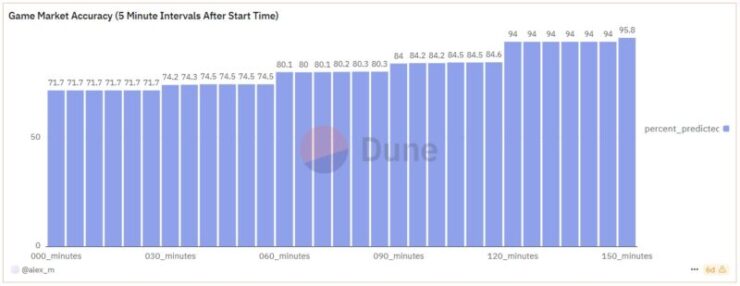New research has revealed just how precise Polymarket’s forecasting capabilities are. According to an analysis by New York-based data scientist Alex McCullough, the decentralized prediction platform achieves 90% accuracy in predicting event outcomes one month in advance and an even sharper 94% accuracy just hours before an event concludes.
McCullough’s findings, published via a comprehensive Dune dashboard, examined Polymarket’s historical data while controlling for outlier conditions. Specifically, the study excluded markets with extreme probability skews—those already sitting above 90% or below 10% after the event outcome was publicly known but not yet settled—to avoid skewed results.

While the platform’s predictive performance is notably strong, McCullough also identified slight but consistent tendencies for Polymarket to overestimate certain outcomes. The research attributes this to factors like herd mentality, liquidity limitations, participant risk preferences, and common psychological biases such as acquiescence bias.
Nonetheless, Polymarket’s high accuracy rates, particularly close to event deadlines, reinforce its growing role as a reliable gauge of public sentiment and collective intelligence, outperforming traditional polling methods in many cases.
Longer-Term Predictions Benefit from Obvious Outcomes
While Polymarket’s accuracy rate is undeniably impressive, data scientist Alex McCullough offers key insights into why certain predictions, particularly longer-term markets, tend to show higher success rates.
In an interview with Polymarket’s The Oracle blog, McCullough explained that extended time frames often include outcomes that are easier to predict, inflating overall accuracy.

He cited the example of a heavily wagered Polymarket contract during the last U.S. election, where bettors speculated on whether Gavin Newsom would become president. The market ultimately leaned toward the clear likelihood that Newsom would not win, which helped skew long-term prediction accuracy positively.
In contrast, McCullough noted that head-to-head sports markets present a more balanced and less predictable environment devoid of such extreme, easily dismissed outcomes.
These markets provide a more transparent reflection of forecasting skill, improving accuracy steadily as events draw nearer. His analysis showed that while Polymarket’s broader numbers highlight strong predictive power, the platform’s performance becomes even more telling in evenly matched, short-term event markets—where sharp spikes in accuracy are observed as new information filters in.
Sports and Politics Drive Polymarket’s Expanding Influence
Polymarket’s growing dominance isn’t confined to political forecasts—it’s also making waves in the world of sports. According to Polymarket Analytics, the platform has recorded nearly $4.5 billion in total volume wagered across major sporting events, including the NBA, MLB, Champions League, and Premier League finals.
This surge in activity highlights how decentralized prediction markets are becoming integral for both entertainment and strategic insights.

Beyond sports, Polymarket’s predictive accuracy is drawing attention from political circles. Recent market trends on the platform suggest that Mark Carney, the new leader of Canada’s Liberal Party, is leading the race against Conservative rival Pierre Poilievre—a lead that outpaces traditional poll aggregators.
Polymarket’s crowd-driven forecasts offer a real-time pulse of public sentiment, often serving as an alternative or complementary tool alongside conventional polling data for policymakers, analysts, and even political operatives.
Quick Facts:
- Research shows Polymarket achieves 90% accuracy predicting events one month out, rising to 94% just before the event concludes.
- The analysis excluded skewed markets to ensure clean data, focusing on realistic probability ranges.
- Slight overestimations were observed, linked to factors like herd behavior and participant risk appetite.
- Polymarket’s accuracy highlights its growing role as a reliable indicator of public sentiment and real-world event outcomes.





